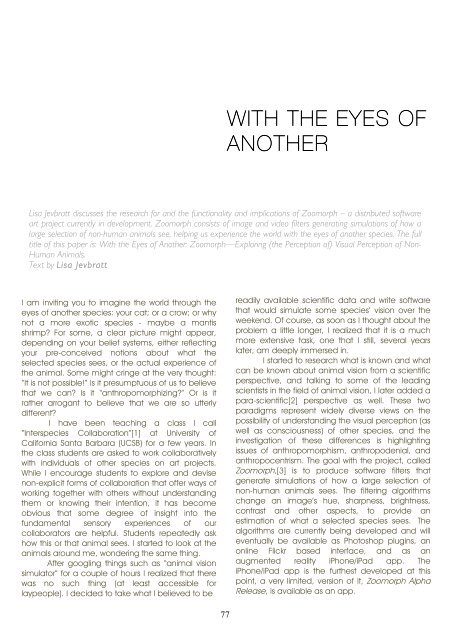Animal Influence I - Antennae The Journal of Nature in Visual Culture
Animal Influence I - Antennae The Journal of Nature in Visual Culture
Animal Influence I - Antennae The Journal of Nature in Visual Culture
You also want an ePaper? Increase the reach of your titles
YUMPU automatically turns print PDFs into web optimized ePapers that Google loves.
I am <strong>in</strong>vit<strong>in</strong>g you to imag<strong>in</strong>e the world through the<br />
eyes <strong>of</strong> another species: your cat; or a crow; or why<br />
not a more exotic species - maybe a mantis<br />
shrimp? For some, a clear picture might appear,<br />
depend<strong>in</strong>g on your belief systems, either reflect<strong>in</strong>g<br />
your pre-conceived notions about what the<br />
selected species sees, or the actual experience <strong>of</strong><br />
the animal. Some might cr<strong>in</strong>ge at the very thought:<br />
“It is not possible!” Is it presumptuous <strong>of</strong> us to believe<br />
that we can? Is it “anthropomorphiz<strong>in</strong>g?” Or is it<br />
rather arrogant to believe that we are so utterly<br />
different?<br />
I have been teach<strong>in</strong>g a class I call<br />
“Interspecies Collaboration”[1] at University <strong>of</strong><br />
California Santa Barbara (UCSB) for a few years. In<br />
the class students are asked to work collaboratively<br />
with <strong>in</strong>dividuals <strong>of</strong> other species on art projects.<br />
While I encourage students to explore and devise<br />
non-explicit forms <strong>of</strong> collaboration that <strong>of</strong>fer ways <strong>of</strong><br />
work<strong>in</strong>g together with others without understand<strong>in</strong>g<br />
them or know<strong>in</strong>g their <strong>in</strong>tention, it has become<br />
obvious that some degree <strong>of</strong> <strong>in</strong>sight <strong>in</strong>to the<br />
fundamental sensory experiences <strong>of</strong> our<br />
collaborators are helpful. Students repeatedly ask<br />
how this or that animal sees. I started to look at the<br />
animals around me, wonder<strong>in</strong>g the same th<strong>in</strong>g.<br />
After googl<strong>in</strong>g th<strong>in</strong>gs such as “animal vision<br />
simulator” for a couple <strong>of</strong> hours I realized that there<br />
was no such th<strong>in</strong>g (at least accessible for<br />
laypeople). I decided to take what I believed to be<br />
77<br />
WITH THE EYES OF<br />
ANOTHER<br />
Lisa Jevbratt discusses the research for and the functionality and implications <strong>of</strong> Zoomorph – a distributed s<strong>of</strong>tware<br />
art project currently <strong>in</strong> development. Zoomorph consists <strong>of</strong> image and video filters generat<strong>in</strong>g simulations <strong>of</strong> how a<br />
large selection <strong>of</strong> non-human animals see, help<strong>in</strong>g us experience the world with the eyes <strong>of</strong> another species. <strong>The</strong> full<br />
title <strong>of</strong> this paper is: With the Eyes <strong>of</strong> Another: Zoomorph—Explor<strong>in</strong>g (the Perception <strong>of</strong>) <strong>Visual</strong> Perception <strong>of</strong> Non-<br />
Human <strong>Animal</strong>s.<br />
Text by Lisa Jevbratt<br />
readily available scientific data and write s<strong>of</strong>tware<br />
that would simulate some species’ vision over the<br />
weekend. Of course, as soon as I thought about the<br />
problem a little longer, I realized that it is a much<br />
more extensive task, one that I still, several years<br />
later, am deeply immersed <strong>in</strong>.<br />
I started to research what is known and what<br />
can be known about animal vision from a scientific<br />
perspective, and talk<strong>in</strong>g to some <strong>of</strong> the lead<strong>in</strong>g<br />
scientists <strong>in</strong> the field <strong>of</strong> animal vision, I later added a<br />
para-scientific[2] perspective as well. <strong>The</strong>se two<br />
paradigms represent widely diverse views on the<br />
possibility <strong>of</strong> understand<strong>in</strong>g the visual perception (as<br />
well as consciousness) <strong>of</strong> other species, and the<br />
<strong>in</strong>vestigation <strong>of</strong> these differences is highlight<strong>in</strong>g<br />
issues <strong>of</strong> anthropomorphism, anthropodenial, and<br />
anthropocentrism. <strong>The</strong> goal with the project, called<br />
Zoomorph,[3] is to produce s<strong>of</strong>tware filters that<br />
generate simulations <strong>of</strong> how a large selection <strong>of</strong><br />
non-human animals sees. <strong>The</strong> filter<strong>in</strong>g algorithms<br />
change an image’s hue, sharpness, brightness,<br />
contrast and other aspects, to provide an<br />
estimation <strong>of</strong> what a selected species sees. <strong>The</strong><br />
algorithms are currently be<strong>in</strong>g developed and will<br />
eventually be available as Photoshop plug<strong>in</strong>s, an<br />
onl<strong>in</strong>e Flickr based <strong>in</strong>terface, and as an<br />
augmented reality iPhone/iPad app. <strong>The</strong><br />
iPhone/iPad app is the furthest developed at this<br />
po<strong>in</strong>t, a very limited, version <strong>of</strong> it, Zoomorph Alpha<br />
Release, is available as an app.












